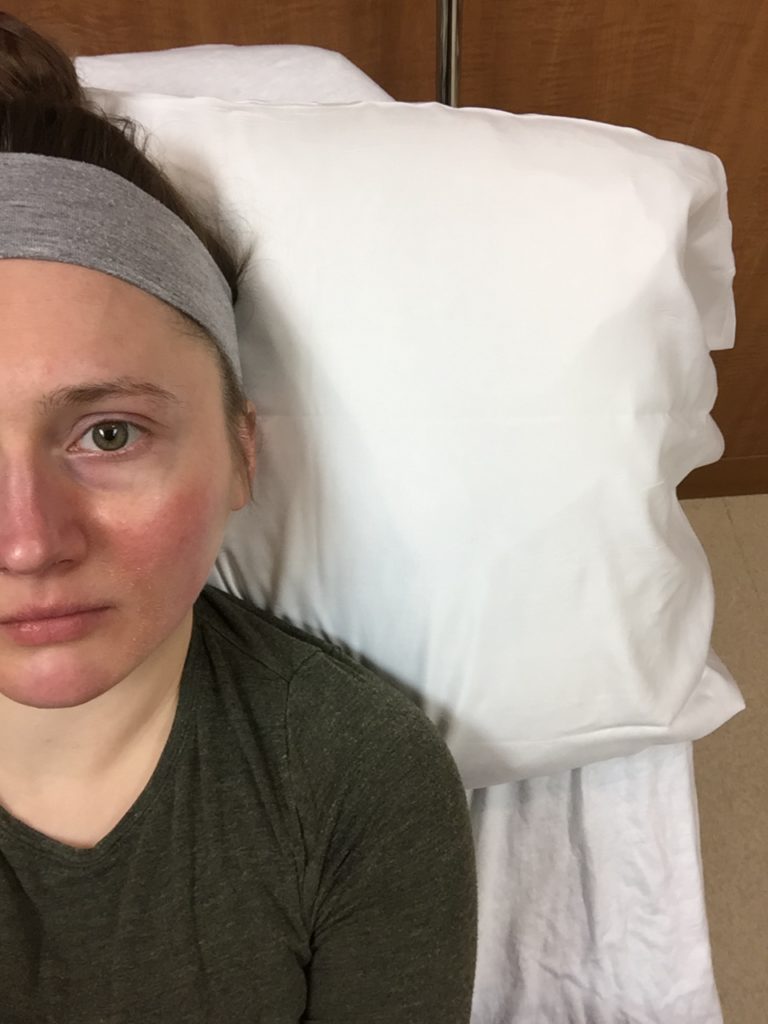A colectomy is a surgery to remove the colon from the body. IRA stands for ileorectal anastomosis. The plan is to take down the stoma, remove my colon, and then attach the small intestine to my rectum. Yes it is possible to live without a colon and I am living proof. Here is the story of my surgery.

From the time I got news from my surgeon about moving my IRA surgery up (I got the call on September 27) to the actual surgery date on October 11, I was in survival mode. Pain at my stoma site was constant 24/7. The fear of having a blockage at the retracted stoma opening was a real concern and the only way to prevent it was to eat very small portions or all liquid food. You can read about my experience with my ileostomy here. I was hungry and tired and counted down the days until I would yet again go onto the operating table. To be honest, I was in so much discomfort each day that an operation seems like a relief. I knew getting my colon out was irreversible, and there “could” be complications, but I didn’t second guess this choice. I was 99% excited and 1% nervous. This was the surgery I knew I wanted all along. I remember the follow up visit with my gastroenterologist after my colonoscopy in November 2018. He explained this surgery and how it would relieve colonic inertia. This gastroenterologist thought I may end up with an IRA reconnection someday. As much as that news was a shock, I knew that God intended for me to have this surgery. And here I am almost a year later, waiting eagerly to have my colon taken out forever.
When the body is depleted and “starving” for nutrition and food, it’s hard to focus and concentrate. My school work was hard to finish and I just wanted to be on the other side of surgery. The actual day came up so fast, that I didn’t have time to worry or ruminate about the complications. Thankfully this was probably God’s plan for me, knowing I love to research and find out all the information possible. But due to my decreased concentration and lack of time, I just went into the surgery, trusting in my surgeon and family to help me after. I knew my body was capable of this and I prepared as best as I could. I ate more protein daily to help build up the stores that I would need to heal my tissues after surgery. I got my room and clothes at home ready to have everything easily accessible.
October 11, 2019 5:00 am. I hardly got much sleep to be honest. This was due to waking up 5x to actually change my ostomy bag (not just empty it), I was in pain and hungry! I did just clear liquids on October 10, but didn’t need any laxatives or bowel prep. Hurray for that, because there was no way I wanted to touch laxatives again. I had a simple hospital bag packed with an outfit, phone charger, a few baby food pouches and tuna packets (incase I wanted something besides hospital food), and threw in a few depends women’s diapers.
I was well prepared for what was to come in terms of bowel movements. My surgeon warned me it would be from 6-20 times a day. I remember receiving this information, and my first reaction was, “that would be wonderful!” Most people would think going to the bathroom that many times a day is not having a quality life. But for me, that sounded like a miracle because I dealt with debilitating constipation or colonic inertia for most my life.
I also want to note that the loop ostomy was a very important diagnostic tool to help my surgeon and I determine how my body would react with permanently taking out the colon. It proved that my small intestine did work and my bowel movements would be about 6x a day (if it stayed consistent with my ileostomy output since I emptied the bag 6x a day.) The hope was that my electrolytes were being properly absorbed by my small intestine instead of the colon, and I would not experience extreme dehydration since things were bypassed for 5 months. But we wouldn’t know for sure until after the procedure how my body would react. Given that my BMI was clinically underweight, I had more of a risk for post surgical complications. UR
8:00 am I’m out the door and it starts to snow for the first time of the year. We were expecting a big snow storm in Minnesota actually over the weekend. But I still decided to go without a coat, because it’s not like I was going to be outside. I learned over the past several hospital stays that I need so little when staying at the hospital. Basically they have everything you need! My dad drove me to the hospital and actually he was the only family in town for this surgery. By now I was used to surgery and it didn’t scare me. I wished my mom was here too, but she was out of town for another month. So my dad and I headed 30 min to the hospital which was a familiar route.
9:00 am My dad drops me off at the maim entrance and I know exactly where to go to check in at Surgery Admitting. I get my picture taken for the new hospital system profile. My dad finds me and after I sign all the paperwork, we head upstairs to the surgery prep wing. I actually stayed here after one of my prolapse surgeries because all the post-opt rooms were full. Everything is so familiar and I wasn’t stressed. I was hoping and praying my bag would stay on just a few more hours until surgery. I decided to not even bring back-up supplies. I was determined the ostomy bag I put on this morning was going to be my last and I was pretty lucky my body cooperated. Though since I wasn’t eating, my stoma was not retracting and pulling inside, and any liquid that came out was properly going into the bag. If I were eating the day before, this would be a different story and my stoma would be retracted inside and liquid seeping out the edges.
I am asked my name and birthday every 5-10 minutes or so which is typical of hospital staff before surgery. I am told to change into the “bair hugger” operating gown that can heat up to keep my body temperature stable. I’m brought into a huge pre-opt room will a wall full of windows. I probably got the nicest in the hospital! My dad meets me in there and we are in awe of the winter storm clouds rolling in. The view kept us pretty happy for hours as we waited.

10:00 am the pre opt nurse comes in and successfully puts in 2 iv’s needed for surgery, one in my hand and one in my arm. Blood had been taken and was sent down to the lab. We got a call 30 min later and by the tone of the nurses voice, I knew something was up. My potassium was significantly low due to 24+ hours of only liquids. So without raising it to a healthy level, surgery couldn’t be started. Since nothing can be given by mouth at this point, IV potassium was ordered. We ran into a problem because I have a lidocaine allergy and lidocaine is needed to buffer the topical burn that accompanies IV potassium. The nicest anesthesiologist was assigned my case and he decided to just start the IV potassium without lidocaine after I am put to sleep and before they start operating.
11:00 am My surgery was supposed to start by now, but my surgeon had 2 cases earlier this morning down the road at the hospital’s same day procedure clinic. I remember he specifically scheduled my surgery so mine was the main case of the day. It was estimated to be a 4-6 hour surgery. And while we waited, my dad and I talked over the phone to my sisters and mom. I got up to go to the bathroom and got really lightheaded due to low potassium. I was so ready to be done with this ileostomy bag.
12:00 pm Dr. B, my surgeon arrives! He comes with news that his plan has changed regarding the type of surgery he will be doing on me. Instead of doing a completely robotic surgery, I would have my colectomy done laparoscopy and the reconnection IRA part done more manually. There were a few reasons for this last minute change. One was that his assistant surgical PA got called home for a family emergency. So the main help he has now is a surgical nurse (whom he trusted very much). There were also no surgical residents who had enough experience to rely on solely for help. So instead of the PA helping with the robotic arms, the surgical nurse would be the one helping with the laparoscopic ports. Also, given my small size, I had to be treated like a pediatric case. I’m only 5’1” and 100 lbs so the 5 robotic arms would not have fit horizontally in my abdomen, while being spaced 1-2in apart. The laparoscopic ports could be placed in different locations and were smaller entry ports. The only downside is that my pelvic bikini scar would be bigger because he would need more room to pull out my colon and surgical attach my small intestine to my rectum. Dr. B assured me that he has done it this way for the longest time and it has a high success rate. I was totally ok with this change and trusted God had this under control.
I then ask Dr. B one last time of the surgical plan and have him promise me that he won’t keep any of my colon, not even a few centimeters. He agrees, even though typically he keeps part of the sigmoid for most patients. Deep inside, I knew my whole entire colon needed to come out and I spoke up clearly with my wishes. Since my surgeon was the one who did my ileostomy and my prolapse revision, he trusted that I knew what I wanted. I am thankful for that and I trusted him too.
Dr. B mentions that he first has to eat lunch and then will be meeting me in the operating room! He gets up and shakes my dad’s hand and I see in my dad’s eyes the trust he has in my surgeon. This gave me reassurance and peace. We had to trust him with my life since he would be opening up my body and removing an organ. As he walks out the room, he turns around and points at me. “I’ll see you in there “. Even though I won’t remember him in there because i’ll be asleep, it gives me comfort that he will be there the whole time making sure I get through it. At that moment it hits me that this is a really big surgery. My nerves kick in and I break out in a cold sweat, but look over at my dad and he reassures me of the whole thing. I need this surgery and I have been preparing all year! We have all out family and friends praying too, it will be ok.
1:00 pm The pre operating IV antibiotic was brought in, so I knew we were getting close to the actual surgery time! The nurse anesthetist (who was young and looked like my age actually) comes in with the very nice surgical nurse and they go over the plan with me. I ask them if I can please be awake and get to see the operating room. They agree to give me a small dose of the nerve reducing anesthesia medication so I can see the whole thing. I give my dad the biggest hug goodbye and tell him “I’ll see you later!”. One last glance and they are wheeling me down the hall. The nurse anesthetist pushes a small dose of the medication and honestly I didn’t feel any different. I am pretty sure I was becoming resistant to this medication after receiving it so many times this year before the operating room.
I get in the operating room and boy it is cold! I remember everything positioned so perfectly in the room and they explain the pieces of equipment. I move myself onto the hard operating bed and help them position my arms and legs. At one point the nurse anesthetist smiles at me and asks “are you getting sleepy at all?” At that point they put on the oxygen mask and decided to give me the stronger meds to really knock me out. “Oh my goodness, this is it I thought”, as I took a big breath. And that was that, I was fast asleep.
2:00 pm My surgery starts. I obviously wasn’t wake for this part, but I will fill you in from what my dad and surgeon told me. My dad goes to wait in the waiting room, assuming it will be 4-6 hours. By the 5 hour mark, there was still no word and my name had not appeared on the surgical board. People went home and the hospital cleared out, until he was the last one waiting there alone. He got nervous thinking something went wrong, and finally at 10 pm Dr. B walks out to let me dad know what happened. He says that my surgery went well (phew! what a relief for my dad). But the surgery did take 8 hours, and there were a few reasons why it took so long. One reason was because my surgeon is very thorough and careful, so he takes his time. Also, my weight was low and he had to be extra careful not to knick any organs or bone when he was cutting the colon away from the connective tissue.

I had 4 laparoscopic incisions, but the one by my left hip was actually not usable because it was placed too close to the bone. Instead to get a better view, he cut the bikini incision a few inches longer, so it ended up being about 5 inches. Nothing went wrong, it was just slightly different than expected. After pulling out my colon, Dr. B noticed that my colon was very dilated, stretched out, longer than normal, and atonic (no muscle tone). One concern he saw, was that my rectum was also stretched out and dilated. So during surgery, he proceeded and cut off the colon from the rectum muscle. After cutting out and pulling the colon from my body, the next step was to attach the small intestine to the rectum. Once he stapled the 2 together, immediately the rectum shrank to normal size, compatible to fit the small intestine’s diameter. Crazy how my body did that so naturally and how surgery can be used to perfect a dysfunctional body. My insides were being rearranged to be given the chance to work again.
Though before cutting the colon away, he cut the stoma away from the abdominal wall and the internal stitches he placed in August to prevent the prolapses. He saw the stitches were still nicely intact and no additional scar tissue was made after that surgery. The ends of the colon and small intestine were stapled, so he could cut the colon out without anything seeping into my abdominal cavity. Then about 20 cm or 8 inches was removed of my small intestine before attaching it to the rectum. There needed to be good blood flow to connect the two successfully. My blood vessels previously attached to the colon were divided and redistributed to my small intestine.
As they were operating, they had to manually move my body from left side to right side to obtain the angles they needed. They also saw my uterus and it was moved gently to the side to get a clear field. The ileum of my small intestine was then connected to my rectum (hence the name, ileorectal anastomosis). It was done so with a surgical instrument that fused the 2 ends together with circle staples. These surgical staples will remain in my body forever. I personally think this was a fascinating surgery! My colon, with my appendix attached, was then sent to pathology for further testing.
11:00 pm I remember laying in the recovery bed and opening my eyes for the first time. It was a relief to be on the recovery floor and it was a familiar spot. I felt a lot of pressure in my head from the pain meds and anesthesia and my whole body was shaking. I’m not sure why it was shaking, maybe pain or maybe because I was cold. The nurse asked me if I am in pain and actually I said “yes”. I was too afraid to push the button with the dilaudid opioid, so I asked the nurse to. I actually didn’t feel relief from it but only an overwhelming wave of nausea that made my body shake more. I close my eyes and dose off but am startled by my surgeon Dr. B. He grabs the side rails of the bed and looks me in the eye to asks “Caroline, how are you?” I’m thinking…well it feel like I have been cut open! I can barely talk. But I managed to nod and say “ok”. He smiles and I hear him talking to the nurse letting her know how much blood I lost. It was 136 ml and thankfully this is minimal!

Next thing I know, they are wheeling me down the hall to my recovery inpatient room. As we get to the 4 west floor, and my dad rushes up beside me and smiles huge. He says to me a few times, “You did so well sweetheart!” and the sound of his voice made the world ok again. He actually was one step ahead of everyone else. My dad just knew the floor to go to and went on his own without waiting for the surgical pager to buzz. He knew I wanted to see him right away and I am so glad he was there.
We wheeled together to the room at the end if the hall. It had a big window but it was midnight by now. My dad notices my body shaking right away and asks if everything is ok. “I don’t know why this is happening” and was just as confused as him. My body had a mind of its own and it’s something I had never experienced before. I was scared but I was not alone. I muster up the brain powder and ask if everything went ok? He said “Yes it did. The whole colon is out, it just took a little longer than expected, but I’m all reconnected”. And so he pulled up a chair and sat with me for hours. I keep shaking and hesitantly ask for 1 more dose of the dilaudid. Again it didn’t help, but only made me incredibly nauseous. I was so thirsty and so I kept asking for ice and more ice and water. At one point the water just started spewing out of my mouth and it kept coming out. I aimed it over the bed and unfortunately onto my dad a few times. My dad was so patient and never got upset. The nurse wasn’t happy and took away all the ice and water. This was just a little bit of the tough love she gave me through the night. Eventually at 3am my dad said he has to get some sleep. So he said goodbye and that he was going to come in the morning.

I was wondering when I would first go poop. So I asked the nurse and she said most people take several days. I was alittle surprised because I thought it would be sooner. I ended up sleeping until the morning hours. It wasn’t even light out and 2 nurses came in. I must have told them my pain was ok during the night because I didn’t want the opioid. So this morning, Saturday October 12, I ask for IV Tylenol and they said they would ask the doctor on call. It took forever, like things normally do on weekends in the hospital and I decided that there was no way I was going to press the pain button again and experience that nausea. I guess I would just deal with the pain.
The next thing was the heparin injection, blood draw labs, and then attempting to walk. I had 3 IV sites, because one blew during surgery from the potassium. The morning “walk” was torturous. But actually even rolling to the side was hard. I needed help sitting up and when I did, my whole abdominal cavity dropped physically. It felt so strange and the gas pains were all around my abdomen. There was alot of gas, just like my ileostomy surgery. I actually think the gas pain was probably the worst part. I managed to stand and take 2 steps with 2 nurses helping me. I felt as if I were going to pass out and begged to lay down. We tried this again and the 3rd time, my dad was there to watch. I knew I needed to move, but my body has never felt so weak in my life. I kept thinking to myself “why can’t I do this? Why cant I walk like after my first surgery?”. The truth is, I was malnourished and was skin and bones. I had no reserves, no pain meds, and was physically past my limit. Tears streamed down my face as my body shook trying to walk to the door. The one nurse kept telling me one more step until my dad even stepped in and said “no more right now”. He saw what I felt.

My hair was a mess, my body was swollen and covered in surgical glue and iodine. I was hungry, thirsty and in pain. Each hour I focused on what was only right in front of me. It kinda felt like I was dying. As an outsider, my dad explained that he also saw my grandpa struggle in a similar way after he had open heart surgery. My dad was there for him, like he is here for me right now. He sat there, lovingly watching me hour after hour. I was in pain and relearning how to function without an organ. I could never have asked for more and am so lucky to have him. This colon surgery I had was pretty big.
My only wish now was that I wanted to poop. I was ok to drink clear liquids and had juice and water. I needed IV potassium again because my levels were low and it was administered at the slowest rate to prevent the burn without lidocaine. Eventually I was transitioned to the fizzy oral potassium drink. Dr. B was not in town during the weekend so the doctor on call made rounds to see me. He didn’t “ok” the Tylenol for some reason and didn’t even listen to my belly, but only looked at my incisions and went on his way. My old stoma site was tied shut with a single loop stitch. The other incisions were glued shut. It was amazing to see no ostomy bag. My dad just sat with me and I was mostly silent or sleeping. He talked with my mom and sisters and brother. I heard their voices and they told me how proud they were of me. But I could barely get out a “hi”.
Sunday October 13, 2019. It is the anniversary of Our Lady of Fatima and I pray today will be the day I poop. I just wanted to poop naturally for the first time in over 10 years. In the morning I felt gas and my intestine popping, juggling and sloshing to the sides. Those big shifts in my abdominal cavity were some of the strangest feelings. My intestine were trying find their new place without a big sluggish colon sitting there. Around 5 pm all of a sudden, my intestine started to get some gas out. An hour later, it was a constant trickle and flow and I learned that the depends diapers are life savers! It was humbling but also a relief! I remember in the middle of the night, I could’t hold it until the nurse came to get me to the toilet. After she came and got me to the toilet, I sat there and cried thinking of about how I just pooped myself. She wiped down my body and my back the gave me a fresh diaper. I still had my catheter in from surgery because it was too difficult to get up to walk to the toilet without her assistance. This new nurse was probably the nicest nurse I had and reassured me it will be ok, and it will get better. I got a few hours of sleep that night before my bowels woke me up again. But I am not complaining, I loved it!

There were many times where I actually just went in the diaper in bed because I was too exhausted to get up to the toilet. But the nurses really encouraged me to tell them a.s.a.p. so I could learn to go poop on the toilet. It was like potty training all over again. It was frustrating and painful at first, relearning and experiencing how my bowel movements were now functioning. The weeks leading up to the surgery I was worried if I would remember how to “go” after having an ileostomy for 5 months. But the body is amazing and I sure remembered. Without a colon, the stuff coming out was pure liquid and would be that way until I start eating and the intestine relearn to absorb water like the colon once did. This was all unknown territory for me.
I was still full of drugs from surgery and happy one moment and sad the next. I also remember missing my mom so much Sunday night and just wanted her to be sitting by me. But this surgery was not originally planned to be in October. It was supposed to be at the end of November, so she could he home for it. God had other plans and honestly my body wasn’t going to last that long because I was almost starving. I needed the surgery now, my surgeon knew it, and I knew it. Life doesn’t go as planned and I just had to realize this was the way God planned, and it was best.

8 am Monday morning, I was already up from going to the bathroom and trying to walk again. This time they gave me the walker to lean onto and I successfully got to the door and back without anyone supporting me. Dr. B was back and came in to see me. He commented how good I look. I didn’t feel too great, but maybe I was turning a corner. This was my first time talking with him since that moment I saw him post opt. He took a good look at my abdomen and pressed around. He changed the gauze on my stitched up stoma site. He told me about the surgery, explaining that even though it took longer, it went great. He reassured me that he flushed the anastomosis connection site and there was no chance of a leak. None of my colon was left, just the small intestine and rectum. I told him how often I was going to the bathroom since Sunday evening. I said I am so very happy and I love this new intestine. It’s way better than before and I am so thankful. He decided to boost my diet form clear liquids to full liquids for lunch and then if I do ok, a low residual diet for dinner. I still was no on any pain meds and he was shocked by this, but I just did what I had to do. He ordered anti nausea meds which I needed as my intestine were a bit shocked to the eating/drinking food after surgery. I also got my cathedar removed by the nurse soon after he left the room.

Gas was still the worst part about introducing new foods, but my dad stuck around and that helped the time pass. He helped get me up and walking without the walker finally! I was determined by the end of the day to walk to the end of the hall. In total I got in 5 walks on Monday and I think that helped the healing and my intestine start settling in place. Each time I got stronger and it was only 2 days ago I could barley get in 2 steps. My dad brought me fresh grapefruit juice, green juice, and cranberry juice from Trader Joe’s. For diner, I successfully ate scrambled eggs, a few bites of salmon and an ensure drink. At first the small of food was horrendous, but slowly it got better. At 6 pm we talked with some family over the phone and the nurse took out one both IV’s since I was successfully drinking and emptying my bladder. These were all huge steps after having colon surgery only 3 days ago. To me it seems like a miracle that my intestine are working and I was pooping every few hours. I was thankful every hour.
Tuesday October 15 went like this. My blood labs were routinely taken, nurses checked on me, Dr. B checked on me, walked down the hall with no walker and successfully ate. Everytime I went to the bathroom, my dad and I celebrated. Sometimes farts turned into poops, but we just laughed and that is what the diaper is for. My dad knew how much this surgery meant and he kept saying how surreal this is that I have no ostomy bag and I can actually poop for the first time in over 10 years. He shared my joy equally and I am so thankful to have my family walk this journey with me. In total, I was averaging going to the bathroom 12x a day. It would eventually slow down to 6x a day or so after a few weeks.

Dr. B said I successfully had to eat 2 meals and then I could actually go home today. It felt so soon, but I was doing pretty good recovery wise and there wasn’t more the hospital could do. I got out my real clothes and slipped them carefully over my fresh incisions. I was taught how to tape some gauze over my stoma site and what to watch for over the next two weeks. There was very low chance of a rupture at the anastomosis site since my surgeon did a side-to-end connection and flushed the site with saline to check for leaks at the end of surgery.
I am in awe of this new body and am thanking God each day that I got to have surgery, and that it was successful. I felt like I had made it to the finish line, and that I was given another chance at life. No more ostomy bag, no more constipation, no more torturous testing. My dad helped get my things together and got me settled in the wheel chair. He rolled me down the familiar hospital hallways and to the lobby. I was going home today! This was my 7th surgery this year and it was going to be my last.

















































































